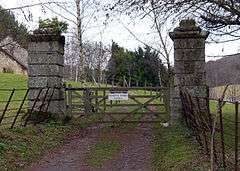Knighton, Isle of Wight

Knighton is a hamlet near to Sandown on the Isle of Wight. It is usually pronounced as Kay-nighton by local people, to avoid confusion with the larger, homophonic village of Niton, near Ventnor.
Knighton is situated under Knighton Down and has historically always been a part of the parish of nearby Newchurch. Knighton consists of little more than a collection of farm houses, most now turned to residential use. The only amenity in the settlement is a post-box. To the south is Knighton Sandpit Ltd which is an aggregate extraction company. The pit is also used for off-road driving events.[1] This is however, a little way from the main residential area.
Knighton Gorges Manor in Knighton was one of the grandest manor houses on the Isle of Wight. But when the owner's daughter married against his will, he had it demolished, rather than letting her inherit it.
Hugh De Morville, one of the knights responsible for the murder of Thomas Becket, fled to Knighton Gorges.
There was a medieval settlement in Knighton, but nearly all of the population moved to Newchurch (which is on higher ground) to escape the black death. Flint arrow heads can still be found in fields surrounding the area.
Jimmy Tarbuck once rented a house in Knighton whilst performing at the nearby town of Sandown.
John Wavell and Anna Cowlam farmed Knighton farm after their marriage in 1735 in Newchurch. They were the great great grandparents of Field Marshal Lord Wavell (1883-1950). Wartime commander and Viceroy of India.
Ghost stories
The area and house is said to be haunted by various ghosts and is a popular stop for ghost tourists. One story often told is that of Sir Tristram Dillington, M.P. for Newport, who is thought to have committed suicide after taking to gambling heavily after the death of his wife. His valet is said to have concealed the nature of his death by placing his corpse upon his horse, Thunderbolt, and driving it into the lake, ensuring that the property was not forfeited.[2] The story is that the ghost of Sir Tristram rides a ghostly horse each year on the anniversary of his death, which occurred on 7 July 1721.[3] The most famous haunting is said to take place on New Year's Eve when, it is claimed, the old house 're-appears', many people often gather at the spot on 31 December to try and witness the phenomenon. It is also said that supernatural creatures or 'gargoyles' appear atop the stone pillars. [It is to be noted that whilst the gates are on a main road, the land itself is privately owned].
References
Coordinates: 50°40′41″N 1°11′59″W / 50.6780°N 1.1998°W